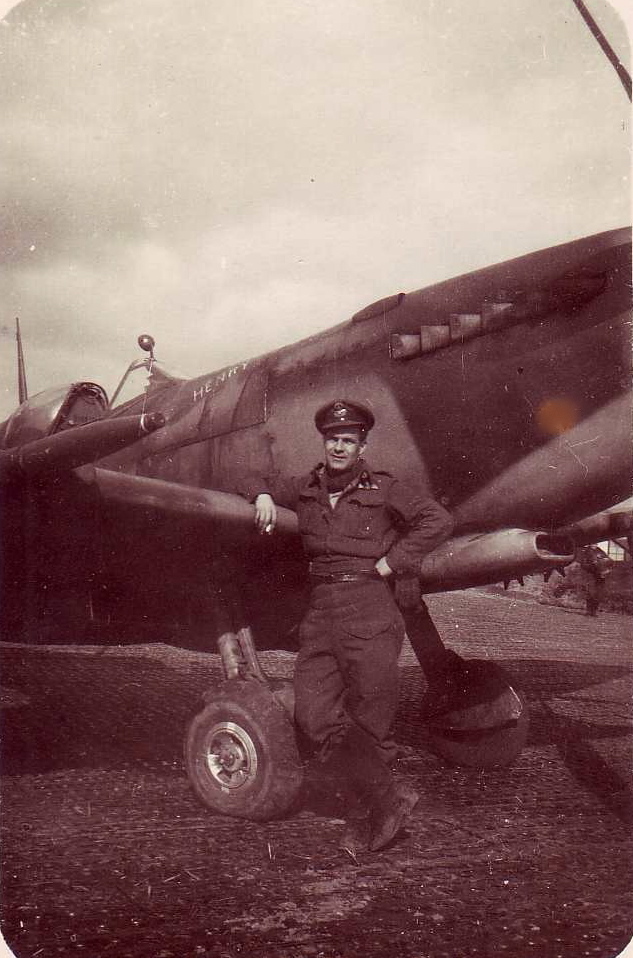This is how Georges Nadon was remembered by…
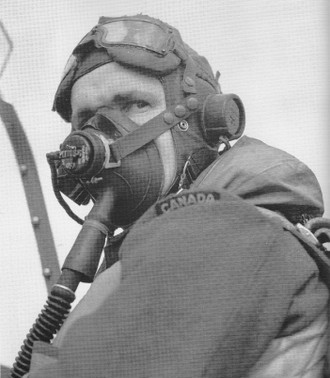
Girlfriends and beer…
Now he is going to be remembered by this…
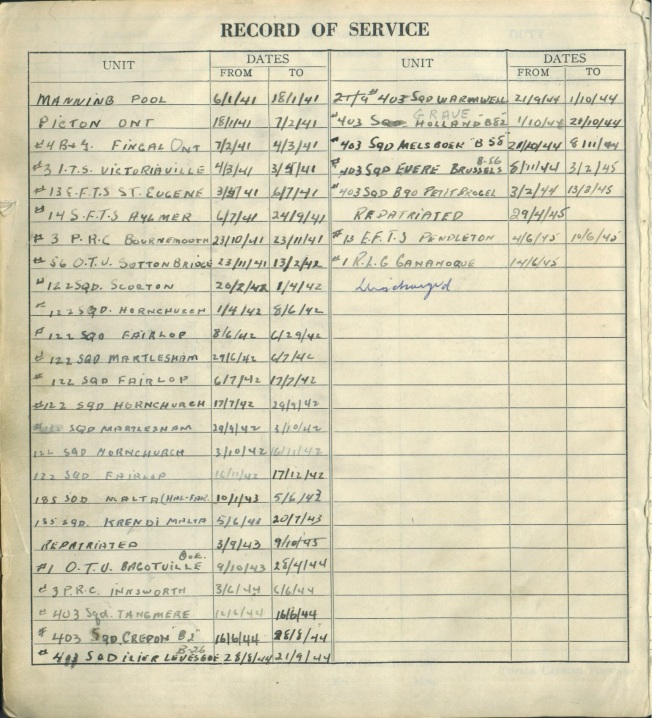
Maybe one of Georges’ children once said:
What did you do in the war Dad?
Georges Nadon would have probably said…
Let’s get on with your homework. I will tell you all about it later.
Georges Nadon’s record of service tells all as well as his complete logbook that I will share with you in the upcoming posts.
First stop was Manning pool where he stayed for 12 days (from 6 January 1941 to 18 January 1941)
Recruits began their military careers at a Manning Depot[6] where they learned to bathe, shave, shine boots, polish buttons, maintain their uniforms, and otherwise behave in the required manner. There were two hours of physical education every day and instruction in marching, rifle drill, foot drill, saluting, and other routines.
Remedial high school education was offered to bring 17 and 18 year old recruits up to the RCAF academic level. There was also a standard aptitude test — the RCAF Classification Test.
After 4 or 5 weeks a selection committee decided whether the recruit would be trained for aircrew or groundcrew. Aircrew “Wireless Air Gunner” candidates went directly to a Wireless School. “Air Observer” and “Pilot” candidates went to an Initial Training School.
Recruits were often assigned “tarmac duty” to keep busy. Some were sent to factories to count nuts and bolts, some were sent to flying schools and other RCAF facilities to guard things, clean things, paint things, and polish things. Tarmac duty could last several months or more.
The No. 1 Manning Depot in Toronto was the Coliseum Building on the Canadian National Exhibition grounds and it accommodated up to 5,000 personnel.
No. 1 Toronto, Ontario
No. 2 Brandon, Manitoba moved to Swift Current, Saskatchewan
No. 3 Edmonton, Alberta
No. 4 Quebec City, Quebec
No. 5 Lachine, Quebec
No. 6 Toronto, Ontario[note 3] (Women’s Division, October 1941 – May 1942)[7]
No. 7 Rockcliffe, Ontario (Women’s Division, Fall 1942)
Wikipedia
Then Picton, Ontario for 20 days (from 18 January 1941 to 7 February 1941) Virtual visit to Picton here.
Off to No. 4 Bomber and Gunnery School (No. 4 B&GS) in Fingal, Ontario, for 1 month only (from 7 February 1941 to 4 March 1941).
(Wikipedia) RCAF Station Fingal was a Second World War British Commonwealth Air Training Plan (BCATP) station located near Fingal, Ontario, Canada. It was operated and administered by the Royal Canadian Air Force (RCAF).
Fingal hosted No. 4 Bomber and Gunnery School (No. 4 B&GS), which trained bomb aimers and air gunners. The school opened on 25 November 1940 and closed 17 February 1945. Aircraft used included the Fairey Battle, Northrop Nomad, Westland Lysander, Bristol Bolingbroke and Avro Anson.[1] Bombing ranges were located near Melbourne, Frome, Tempo, and Dutton. There was also a bombing range on Lake Erie. A marine unit was based in Port Stanley.[2][3] Classroom facilities with residences were commandeered from Universities, Colleges, The station magazine was the “Fingal Observer”.
This one month stay is most revealing since No. 4 B&G is for training gunners and bomb aimers. Georges Nadon must have shown some potential as a pilot since he was sent to an Initial Training School to get pilot training. This is why we see him following courses at No. 3 I.T.S. Victoriaville, Quebec (from 4 March 1941 to 3 May 1941).
(Wikipedia) Initial Training Schools
Pilot and Air Observer candidates began their 26 or 28 week training program with four weeks at an Initial Training School (ITS). They studied theoretical subjects and were subjected to a variety of tests. Theoretical studies included navigation, theory of flight, meteorology, duties of an officer, air force administration, algebra, and trigonometry. Tests included an interview with a psychiatrist, the 4 hour long M2 physical examination, a session in a decompression chamber, and a “test flight” in a Link Trainer as well as academics. At the end of the course the postings were announced. Occasionally candidates were re-routed to the Wireless Air Gunner stream at the end of ITS.
Then off he went to an Elementary Flying Training school, No. 13 E.F.T.S. St. Eugene, Ontario (from 3 May 1941 to 6 July 1941).
(Wikipedia) Elementary Flying Training Schools
An Elementary Flying Training School (EFTS) gave a recruit 50 hours of basic flying instruction on a simple trainer like the De Havilland Tiger Moth, Fleet Finch, or Fairchild Cornell over 8 weeks.[2] Elementary schools were operated by civilian flying clubs under contract to the RCAF and most of the instructors were civilians. For example, No. 12 EFTS Goderich was run by the Kitchener-Waterloo Flying Club and the County of Huron Flying Club.[3] The next step for a pilot was the Service Flying Training School.
No. 1 Malton, Ontario (Moth)
No. 2 Fort William, Ontario (Moth)
No. 3 London, Ontario (Finch)
No. 4 Windsor Mills, Quebec (Finch and Moth)
No. 5 Lethbridge,Alberta, moved to High River, Alberta (Moth and Cornell)
No. 6 Prince Albert, Saskatchewan (Moth and Cornell)
No. 7 Windsor, Ontario (Finch)
No. 8 Vancouver, British Columbia, moved to Boundary Bay, British Columbia [3] (Moth)
No. 9 St. Catharines, Ontario (Moth)
No. 10 Hamilton, Ontario, moved to Pendleton, Ontario (Moth and Finch)
No. 11 Cap-de-la-Madeleine, Quebec (Finch and Cornell)
No. 12 Goderich, Ontario (Finch)
No. 13 St. Eugene, Ontario(Finch)
No. 14 Portage la Prairie, Manitoba (Moth and Finch)
No. 15 Regina, Saskatchewan (Moth and Cornell)
No. 16 Edmonton, Alberta (Moth and Finch)
No. 17 Stanley, Nova Scotia (Finch and Moth)
No. 18 Boundary Bay, British Columbia (Moth) [8]
No. 19 Virden, Manitoba (Moth and Cornell)
No. 20 Oshawa, Ontario (Moth)
No. 21 Chatham, New Brunswick (Finch)
No. 22 L’Ancienne-Lorette, Quebec (Finch)
No. 23 Davidson, Saskatchewan, moved to Yorkton, Saskatchewan
No. 24 Abbotsford, British Columbia (Cornell)
No. 25 Assiniboia, Saskatchewan — originally No. 34 RAF (Cornell)
No. 26 Neepawa, Manitoba — originally No. 35 RAF (Moth)
No. 31 DeWinton, Alberta — taken over by the Toronto Flying Club. (Moth, Stearman and Cornell)
No. 32 Bowden, Alberta (Moth, Stearman and Cornell)
No. 33 Caron, Saskatchewan (Cornell)
No. 34 Assiniboia, Saskatchewan — taken over by Winnipeg Flying Club as No. 25 EFTS [3] (Moth)[8]
No. 35 Neepawa, Manitoba — taken over by Moncton Flying Club as No. 26 EFTS [3] (Moth and Cornell)
No. 36 Pearce, Alberta (Moth and Stearman)
No. 13 E.F.T.S. will be our next series of articles before going to No. 14 S.F.T.S. Alymer, Ontario, where this picture was taken.
Georges Nadon was there from 6 July 1941 to 24 September 1941.
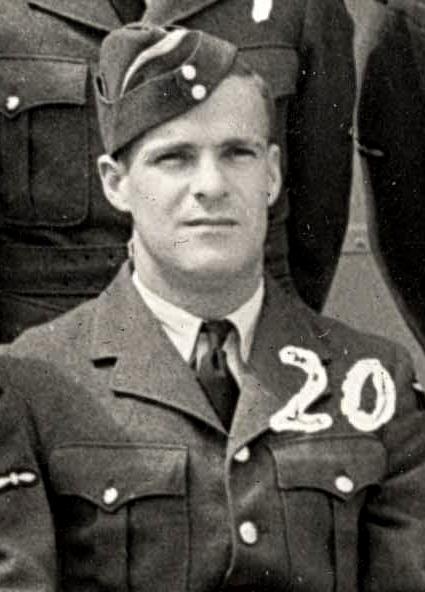
Source of picture
Georges Nadon got his wings at No. 14 Service Flying Training School at Alymer in September 1941, he then we went overseas after a few weeks leave to say goodbye to his parents.
We have some pictures of Georges’ training days in Alymer, Ontario.

LAC Scott and LAC Joffre Ribout (No.14 S.F.T.S. Alymer)

Joffre Ribout (No.14 S.F.T.S. Alymer)

Georges Nadon (No. 13 E.F.T.S. St. Eugene or No.14 S.F.T.S. Alymer)

Sergeant Trumley, instructor (No.14 S.F.T.S. Alymer)
You can click here to view a video of that training school.






















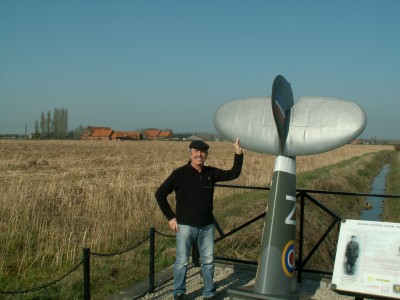


 Le 30 octobre 1937, il réussit les épreuves de sous-lieutenant de réserve et dans le cadre de sa formation d’officier, il suit les cours de l’Ecole d’observation. Le 6 mars 1939 il rejoint à nouveau l’Ecole de pilotage, cette fois comme élève-moniteur. Il obtiendra la qualification le 1er février 1940. Le 10 mai 1940, au moment de l’agression nazie, Léon Prévot est moniteur à la 3ème Escadrille de pilotage de Deurne (Anvers).
Le 30 octobre 1937, il réussit les épreuves de sous-lieutenant de réserve et dans le cadre de sa formation d’officier, il suit les cours de l’Ecole d’observation. Le 6 mars 1939 il rejoint à nouveau l’Ecole de pilotage, cette fois comme élève-moniteur. Il obtiendra la qualification le 1er février 1940. Le 10 mai 1940, au moment de l’agression nazie, Léon Prévot est moniteur à la 3ème Escadrille de pilotage de Deurne (Anvers).










